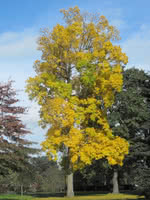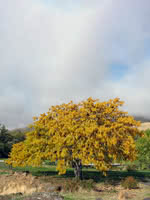Mon-Fri 9am - 5pm Mountain time
Bitternut Hickory vs Thornless Honeylocust
Carya cordiformis
Gleditsia triacanthos inermis
NOT AVAILABLE THIS SEASON - MIGHT RETURN
Bitternut Hickory is a large deciduous tree that makes a great shade tree for yards and parks. This tree is native to Eastern North America. Although it produces nuts, they are bitter and inedible. Some consider this wood to be the best flavour for smoking meats.
Plant Bitternut Hickory in it’s forever home. It is difficult to transplant due to its long taproot, and may not survive.
The wood is strong and has historically been used for wheels, ladders, and furniture.
Thornless Honey Locust makes an excellent shade tree with its lacy foliage and dappled shade. The leaves are honey-yellow, light and airy, providing interesting color and texture to your landscape. This variety is thornless, and the seeds and pods provide food for wildlife such as deer and squirrels.
The Thornless Honey Locust is tolerant of drought, various soil conditions, and even road salt.

